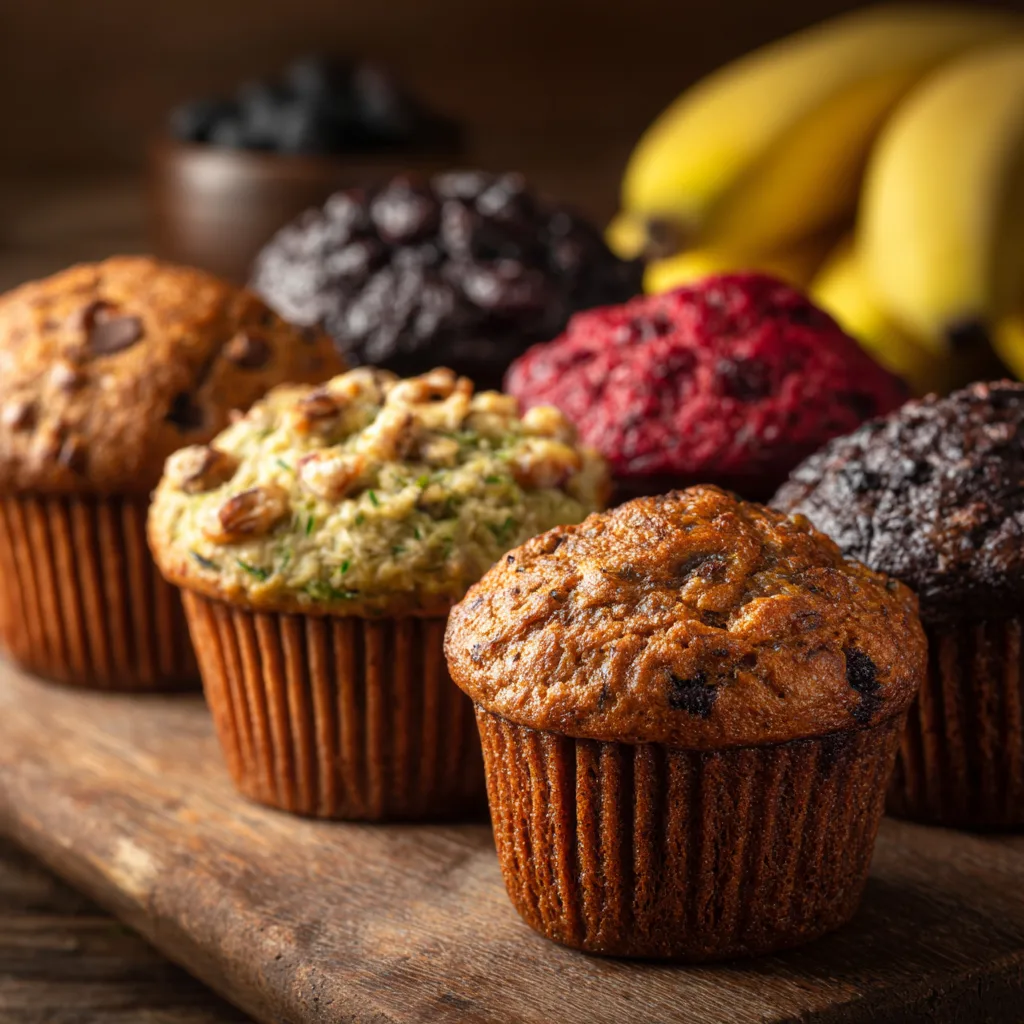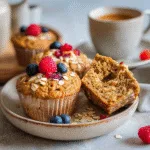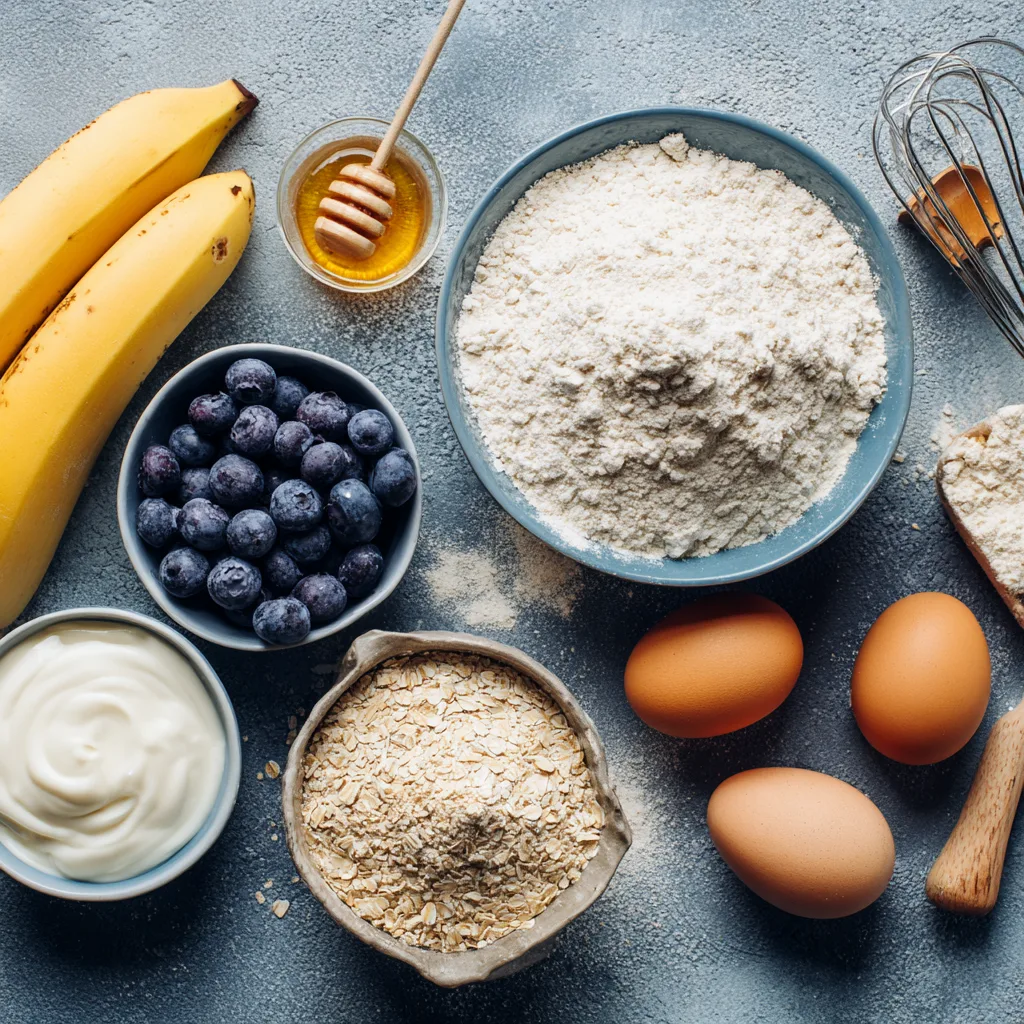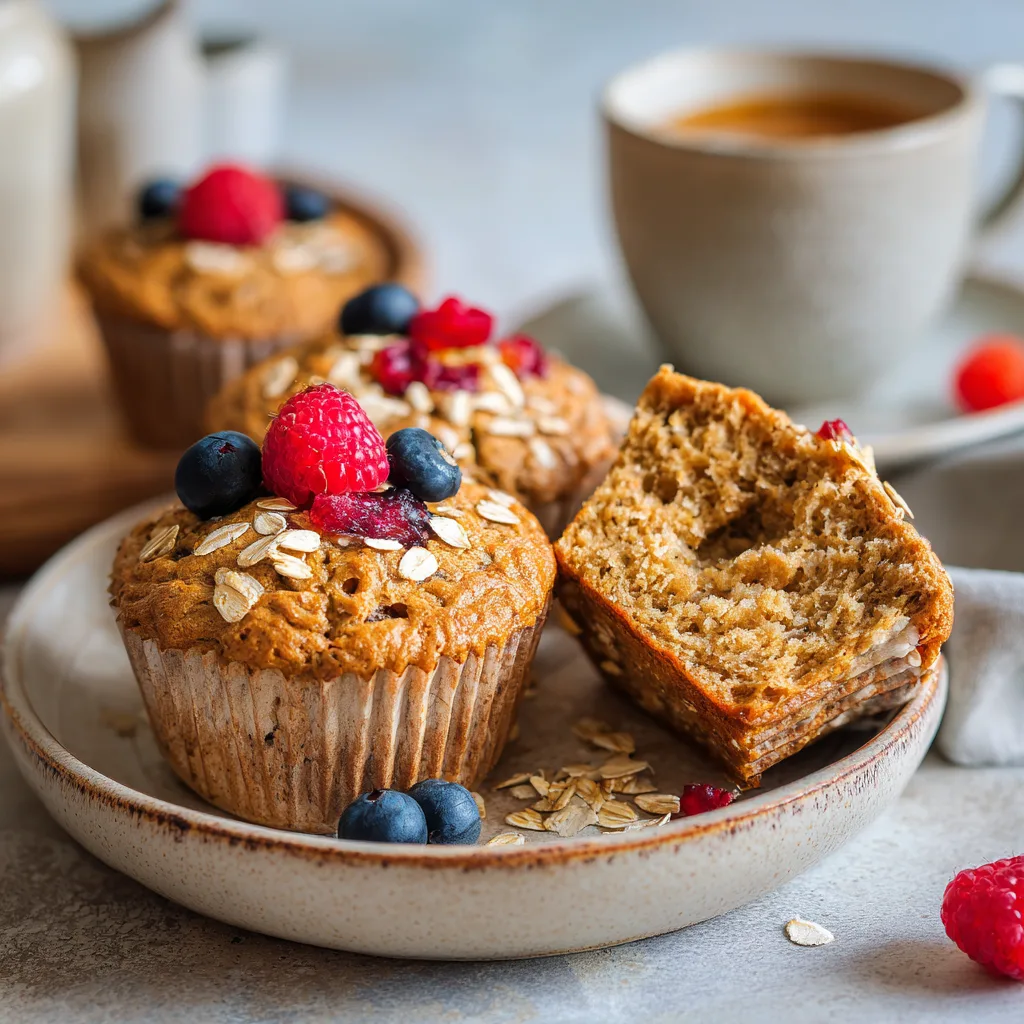Healthy muffin recipes are more than just a trend—they’re a smart, delicious way to fuel your mornings and snack breaks with real, feel-good ingredients. Whether you’re juggling work, prepping lunchboxes, or sneaking in a moment of peace with coffee in hand, muffins offer comfort, portability, and nourishment in one warm bite.
In this article, we’ll cover everything from what makes a muffin “healthy” to ingredient swaps, baking tips, storage ideas, and the 10 ultimate healthy muffin flavors you’ll want on repeat. These muffins aren’t just good for you—they taste incredible too.
Table of Contents
Table of Contents

The Heart Behind These Healthy Muffin Recipes
From Grandma’s Kitchen to My Freezer
When I think of muffins, I think of Saturday mornings in my grandma’s kitchen. The smell of cinnamon and vanilla in the air. Me standing on a step stool, sneaking blueberries from the bowl before they hit the batter. We weren’t using the word “healthy” back then—we were just making food with love, using what we had.
Fast-forward to my own kitchen in Stillwater, Minnesota—mornings are louder, faster, and busier now. But muffins? They’ve stayed the same kind of magic. I’ve learned how to swap sugar for maple syrup, white flour for oat or whole wheat, and sneak in zucchini, flaxseed, or Greek yogurt without losing that soft, warm, bakery-style bite.
Now, healthy muffin recipes are my go-to for breakfasts on the go, lunchbox wins, or a mid-afternoon treat with zero guilt. And I want the same for you.
Explore more Easy Keto Breakfast Ideas here and don’t miss our Freezer-Friendly Smoothies for batch baking success.
What Makes a Muffin Healthy Anyway?
A muffin becomes “healthy” when it skips the empty calories and adds nutrition without losing flavor. We’re talking:
- Whole grains instead of refined flour
- Natural sweeteners like honey or banana instead of sugar
- Healthy fats like olive oil or nut butters
- Protein-rich add-ins like Greek yogurt or almond flour
- Fruits and veggies for fiber, flavor, and moisture
These swaps boost nutrition while keeping muffins moist, fluffy, and totally crave-worthy.
And here’s the best part—you can freeze them, adapt them for different diets, and enjoy them daily without burnout. That’s what this guide is all about.
Print
Healthy Muffin Recipes – 7 Easy, Powerful Ideas for Better Mornings
- Total Time: 30 minutes
- Yield: 12 muffins 1x
Description
These healthy muffins are quick to make, full of nutritious ingredients like oats, banana, and Greek yogurt, and perfect for breakfast or snacks.
Ingredients
- 1 cup white whole wheat flour
- 1/2 cup oat flour
- 1 tsp baking powder
- 1/2 tsp baking soda
- 1/2 tsp cinnamon
- 1/4 tsp salt
- 1/2 cup mashed banana
- 1/2 cup Greek yogurt
- 1/4 cup maple syrup
- 1 large egg
- 1 tsp vanilla extract
- 1/4 cup mini chocolate chips (optional)
Instructions
- Preheat oven to 350°F and line a muffin tin.
- In one bowl, whisk together flours, baking powder, soda, cinnamon, and salt.
- In another bowl, mix banana, yogurt, maple syrup, egg, and vanilla.
- Combine wet and dry ingredients until just mixed.
- Fold in chocolate chips, if using.
- Divide batter evenly into muffin cups.
- Bake 18–22 minutes or until a toothpick comes out clean.
- Cool completely before storing.
Notes
Store in an airtight container for 3 days or freeze up to 3 months.
Great for lunchboxes and meal prep.
Try swapping banana for applesauce or zucchini.
- Prep Time: 10 minutes
- Cook Time: 20 minutes
- Category: Breakfast
- Method: Baking
- Cuisine: American
Nutrition
- Serving Size: 1 muffin
- Calories: 160
- Sugar: 6g
- Sodium: 180mg
- Fat: 6g
- Saturated Fat: 1g
- Unsaturated Fat: 5g
- Trans Fat: 0g
- Carbohydrates: 22g
- Fiber: 3g
- Protein: 5g
- Cholesterol: 30mg
Essential Ingredients for Healthy Muffin Recipes
Pantry Staples for Healthier Muffin Magic
When it comes to healthy muffin recipes, the ingredients matter just as much as the method. The good news? You likely have most of the essentials in your pantry already. Healthy doesn’t mean complicated—it means using smart swaps that bring both flavor and nutrition.
Let’s start with flour. Instead of white all-purpose, opt for whole wheat, white whole wheat, or even oat flour for extra fiber and a heartier texture. Oat flour gives a slightly nutty flavor that works beautifully with fruits like banana or blueberry.
Sweeteners are another place to make a simple upgrade. Replace refined sugar with maple syrup, honey, or mashed overripe bananas. These not only sweeten but add moisture, meaning your muffins stay soft without extra oil.
For fats, skip the butter and try avocado oil, coconut oil, or unsweetened applesauce. You can also use Greek yogurt—which adds creaminess and protein in one spoonful.
Don’t forget the add-ins! Muffins are the perfect place to toss in chia seeds, flaxseeds, grated carrots, zucchini, or shredded coconut. These boost nutrients without sacrificing flavor.
Need more inspiration for clean and fresh ingredients? Check out our Healthy & Fresh recipe collection or browse ideas in Quick & Easy Meals for wholesome favorites that pair well with muffins.
Ingredients That Add Protein and Staying Power
If you’re baking muffins as a breakfast or meal-prep option, adding protein is key. Try folding in a scoop of unflavored or vanilla protein powder, or replacing some of the flour with almond flour for extra healthy fats and protein.
You can also mix in nut butters, chopped nuts, or hemp hearts for texture and nutrients. A spoonful of peanut butter or almond butter pairs perfectly with banana-based muffins and gives them extra richness.
These simple tweaks turn your muffins from a sweet treat into a satisfying, balanced snack that actually keeps you full. And because they’re freezer-friendly, you can always double the batch—one for now, one for later.
In the next section, we’ll dive into the actual baking process and share expert tips for making muffins moist, fluffy, and freezer-ready every time.
Baking Tips for the Best Healthy Muffin Recipes
Moist, Fluffy, and Never Dry: Muffin Technique 101
One of the most common mistakes in baking healthy muffin recipes is assuming healthy means dry or dense. It doesn’t have to! The key lies in the mixing technique and baking temperature.
Here’s the golden rule: don’t overmix your batter. Once the dry and wet ingredients meet, stir just until everything is combined. Overmixing activates the gluten in the flour, which leads to tough, rubbery muffins. Leave a few streaks of flour—it’ll bake out.
Another trick? Start your oven hot, then lower the temp. Try preheating to 425°F, bake for 5 minutes, then reduce to 350°F for the remaining time. This gives your muffins a fast rise with domed, bakery-style tops while ensuring a soft interior.
When using natural sweeteners or add-ins like banana or zucchini, your batter may be thicker or wetter. Don’t worry—this adds moisture, especially after freezing. Just keep an eye on baking time and use the toothpick test to check doneness.
Looking for another easy, wholesome bake? These Banana Oatmeal Bars are packed with fiber and great for breakfast alongside your muffins.
How to Make Muffins Freezer-Friendly and Reheatable
Want to meal prep your healthy muffin recipes? Freezing is your best friend. Once your muffins have cooled completely, wrap them individually in parchment or foil, then store them in a freezer-safe bag. Label with the date—muffins keep well for up to 3 months.
To reheat, just microwave for 30–45 seconds or pop in a 300°F oven for 8–10 minutes. You’ll get a warm, fresh muffin without starting from scratch.
Pro tip: freeze muffins in batches by flavor—this makes it easier to grab what you need (banana today, blueberry tomorrow). This works beautifully if you’re baking a variety, like from our Sweet Treats collection, where you can pair your muffins with healthy desserts.
In the next section, we’ll explore flavor variations—from classic blueberry to savory veggie muffins, and everything in between.

10 Ultimate Healthy Muffin Recipes You’ll Crave Daily
Sweet, Savory, and Packed with Goodness
When you’ve got a solid base and a few healthy swaps in place, the real fun begins—flavor variations. These 10 muffin ideas are tested, family-approved, and freezer-friendly. Whether you love fruity bursts, cozy spices, or veggie-packed goodness, there’s something here for you.
1. Blueberry Oat Muffins
Made with white whole wheat flour, rolled oats, and maple syrup. Fold in frozen blueberries and a splash of vanilla. Moist, fluffy, and perfectly sweet.
2. High-Protein Banana Muffins
Use mashed banana, Greek yogurt, almond flour, and a scoop of protein powder. Add walnuts for crunch. These are ideal for breakfast meal prep.
3. Zucchini Chocolate Chip Muffins
Yes, veggies in muffins! Grated zucchini keeps things moist while mini dark chocolate chips make them kid-approved. Sweetened with honey.
4. Apple Cinnamon Muffins
Diced apple, oat flour, and a sprinkle of cinnamon create that warm, fall flavor. Perfect for school snacks or cozy mornings.
5. Lemon Chia Muffins
Vegan-friendly, with almond milk and coconut oil. Zesty lemon juice, zest, and chia seeds offer brightness and texture.
6. Carrot Cake Muffins
Think dessert meets breakfast. Grated carrots, raisins, walnuts, and a touch of nutmeg. Use maple syrup for a clean sweetener.
7. Pumpkin Spice Muffins
Canned pumpkin, whole wheat flour, and warm spices. Moist and rich in vitamin A—make a double batch during fall.
8. Raspberry Almond Muffins
Almond flour and almond extract pair beautifully with tart raspberries. These feel fancy but are super simple.
9. Savory Veggie & Cheese Muffins
Zucchini, carrot, and sharp cheddar. Great for brunch or as a side dish to soups. Add herbs for depth.
10. Tropical Coconut Pineapple Muffins
Crushed pineapple, shredded coconut, and a little oat flour make this taste like vacation—but healthy.
Looking to pair your muffins with more nourishing recipes? Browse our Healthy & Fresh category or explore savory balance with dishes like Santa Fe Chicken.
Make It Your Own: Mix & Match
You don’t have to follow each recipe to the letter. These muffins are flexible—swap blueberries for raspberries, try almond butter instead of peanut, or add sunflower seeds instead of walnuts for a nut-free lunchbox option.
Next up: we’ll talk about how to make these muffins kid-friendly, with tips for school snacks, picky eaters, and mini muffin versions.
Kid-Friendly & Lunchbox Muffins
Making Muffins That Kids Actually Eat
When it comes to feeding kids, especially during the busy school week, healthy muffin recipes can be a lifesaver. They’re hand-held, portable, freezer-safe, and easy to sneak in fruits, veggies, and fiber without complaints.
Start with familiar flavors—banana, apple, or blueberry—and avoid large chunks or overpowering spices. Use mini muffin pans for kid-sized portions, and opt for natural sweeteners like applesauce or mashed banana to keep sugar low.
Add-ins like carrot, zucchini, or finely grated apple blend in beautifully and go unnoticed. A handful of mini chocolate chips or a light sprinkle of cinnamon sugar on top can make even the healthiest muffin feel like a treat.
For protein, mix in Greek yogurt or nut/seed butters—they’ll help your muffins double as a satisfying snack or breakfast.
Looking for more wholesome kid-approved recipes? Try our easy Blueberry Banana Pancakes or Apple and Sage Turkey Meatballs for lunch or dinner pairings.
Packing & Storing Muffins for School Success
Healthy muffins are ideal for lunchboxes, especially when made in batches. Here’s how to store and pack them like a pro:
- Freeze in mini muffin form and pull out individual servings the night before. They’ll thaw in the fridge overnight or in the lunchbox by midday.
- Wrap muffins in parchment or stash in a reusable silicone snack bag to avoid squishing.
- For picky eaters, add a note or emoji sticker—make it fun and they’ll associate muffins with more than just food.
- Pair with a boiled egg, string cheese, or fruit for a balanced meal.
Bonus tip: Let kids help bake! Measuring, mixing, and choosing flavors gets them excited to eat what they helped create.
Want more quick meal ideas for busy weeks? Check out our collection of Quick & Easy Meals or explore family favorites like Dolly’s Chicken & Stuffing Casserole.
Nutrition & Health Benefits of Healthy Muffins
Small Muffins, Big Benefits
It’s easy to write off muffins as sugary treats, but healthy muffin recipes can be surprisingly nutrient-dense when made with the right ingredients. Each muffin becomes a chance to boost your day with fiber, protein, healthy fats, and essential micronutrients—all in one hand-held, cozy bite.
Here’s what your homemade muffins can deliver:
- Whole grains like oats or white whole wheat flour add complex carbs and fiber for long-lasting energy and digestive support.
- Fruits and vegetables such as banana, apples, zucchini, or carrots bring natural sweetness, vitamins, and moisture without the need for refined sugar.
- Healthy fats from olive oil, nut butters, or seeds help support brain health and keep you feeling satisfied.
- Protein-rich ingredients like Greek yogurt, almond flour, or eggs help balance blood sugar and prevent mid-morning crashes.
Want proof that healthy muffins can still be decadent? Try our nourishing Banana Chocolate Chip Muffins or Apple Cinnamon Muffins—both are naturally sweetened, freezer-friendly, and packed with feel-good flavor.
How Muffins Fit into a Balanced Lifestyle
These muffins aren’t just about sneaking in veggies or skipping sugar—they’re about building a lifestyle that supports real wellness. Whether you’re navigating dietary needs or aiming for more mindful meals, muffins can serve many goals:
- Low-glycemic-friendly when made with slow-digesting carbs and lower sugar options
- Keto-adaptable with almond flour bases and stevia or erythritol sweeteners
- Digestive-friendly when including flax, oats, or chia seeds
- Mood-balancing with ingredients that stabilize blood sugar and reduce the highs/lows of processed snacks
If you’re working toward steady energy and fewer cravings, browse our Low-Glycemic Index Meals or read how food can help regulate mood in Stress-Balancing Nutrition.
Even just one muffin a day—especially when made with purpose—can be a tool for better eating without stress or sacrifice.

Common Mistakes & How to Fix Them
Why Your Muffins Turn Out Dry, Flat, or Gummy
Even the most experienced home bakers hit bumps in the muffin tin. With healthy muffin recipes, these issues can feel even more frustrating—whole grains, natural sweeteners, and lower fat levels behave differently than traditional ingredients. Here’s how to fix that.
1. Dry Muffins?
This usually happens when you overbake, use too little fat, or don’t have enough moisture from fruit or yogurt. Healthy batters are often thicker, which can fool you into baking longer than needed.
Fix: Always check at the minimum baking time and test with a toothpick. Use natural moisture boosters like mashed banana, Greek yogurt, or shredded zucchini to keep muffins soft without adding oil.
2. Gummy or Dense Muffins?
This can happen when there’s too much moisture or overmixing. Whole wheat and oat flour absorb liquid differently than white flour.
Fix: Stir only until just combined—never overbeat. Let the batter rest 5–10 minutes before baking so the flour absorbs the liquid. Try folding dry and wet ingredients together with a spatula instead of a mixer.
3. Flat Tops?
Lack of rise usually comes from expired baking powder or not enough leavening.
Fix: Use fresh baking powder/soda, and try starting your muffins at 425°F for the first 5 minutes, then dropping to 350°F to finish—this creates a dome effect.
Preventing Common Healthy Baking Pitfalls
Healthy baking swaps are amazing—but if you substitute too much too fast, you can end up with a disaster.
- Don’t eliminate all fat—just choose better ones like avocado or olive oil.
- Sweeten naturally, but remember bananas and applesauce vary in moisture—balance with dry ingredients.
- Avoid large muffin liners that cause muffins to spread too much and look flat.
Learning from flops is part of becoming a great baker. Each mistake gets you one step closer to your signature recipe—and that’s the beauty of home baking.
Want to master more nutritious baked treats? Don’t miss our No-Bake Lemon Cheesecake for a healthy dessert or explore Easy Keto Breakfast Ideas if you’re baking low-carb.
FAQs – Healthy Muffin Recipes
What makes a muffin recipe truly healthy?
A truly healthy muffin balances great taste with nutritional benefits. That means using whole grain flours, natural sweeteners, and healthy fats like olive oil or Greek yogurt instead of butter. It also means limiting added sugar and boosting each muffin with fiber, protein, or fruit/vegetable ingredients. A good rule of thumb: if it energizes you without the sugar crash, it’s on the right track.
Which ingredients should I avoid when making healthy muffins?
Skip refined white flour, granulated sugar, and excess butter or vegetable oil. These ingredients lack nutrients and often spike blood sugar. Instead, choose whole wheat flour, maple syrup, or ripe bananas/applesauce to add both nutrition and moisture. Also avoid overly processed “low-fat” products—they often contain hidden sugars.
How can I make muffins that are moist yet low in sugar and fat?
The secret to moist, healthy muffins lies in whole food moisture sources. Think: grated zucchini, mashed banana, pumpkin puree, or Greek yogurt. These add natural moisture without relying on added fat. To keep sugar down, use maple syrup, honey, or fruit puree—and rely on warm spices like cinnamon or vanilla for depth of flavor.
What are the best flours and sweeteners for healthy baking?
For flour, opt for white whole wheat, oat flour, or almond flour—all of which offer more fiber and nutrients than all-purpose. For sweeteners, go with pure maple syrup, raw honey, mashed fruit, or date paste. These add sweetness and texture, while keeping the glycemic load lower than traditional sugar.
How can I store healthy muffins to keep them fresh longer?
Let muffins cool completely, then store in an airtight container lined with a paper towel. Keep them at room temperature for 2–3 days, refrigerate for up to a week, or freeze for up to 3 months. For freezing, wrap individually and reheat in the microwave or oven as needed.

You might also like these recipes
Quick & Easy Meals
Homemade Crispy Bang Bang Salmon Bites
Quick & Easy Meals
Honey Garlic Chicken Breasts
Quick & Easy Meals
Honey Garlic Ground Turkey Recipe